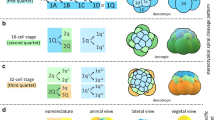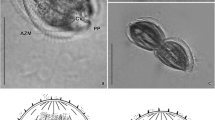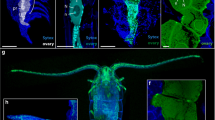Summary
Microplasmodia ofPhysarum polycephalum Schw differentiate into numerous hard walled spherules when deprived of nutrients. Cleavage occurs by invagination of the plasmalemma and growth of furrows centripetally. Cleavage furrows consistently contain ruthenium red positive fibrillar material. As the spherules become more rounded, a compact layer of ruthenium red positive material surrounds their membranes. A spherule wall which does not bind ruthenium red is deposited inside of the stained layer. Clusters of spherules are enclosed by ruthenium red positive material similar to the microplasmodial slime.
Similar content being viewed by others
References
Cheung, L., H. R. Henney, andW. H. Clark, Jr., 1974: Ultrastructure of pure cultures ofPhysarum flavicomum I. Conversion of a plasmodium to microplasmodia and microsclerotia, and the process of slime secretion. Cytobios9, 193–205.
Daniel, J. W., andU. Jarlfors, 1972: Plasmodial ultrastructure of the myxomycetePhysarum polycephalum. Tissue and Cell4, 15–36.
Farr, D. R., H. Amster, andJ. Horisberger, 1972: Composition and partial structure of the extracellular polysaccharide ofPhysarum polycephalum. Carbohydr. Res.24, 207–209.
Goodman, E. M., andH. P. Rusch, 1970: Ultrastructural changes during spherule formation inPhysarum polycephalum. J. Ultrastruct. Res.30, 172–183.
Henney, H. R., andM. Henney, 1968: Nutritional requirements for the growth in pure culture of the MyxomycetePhysarum rigidum and related species. J. gen. Microbiol.53, 333–339.
Luft, J. H., 1971: Ruthenium red and violet. I. Chemistry, purification, methods of use for electron microscopy and mechanism of action. Anat. Rec.171, 347–368.
McCormick, J. J., J. Blomquist, andH. P. Rusch, 1970: Isolation and characterization of an extracellular polysaccharide fromPhysarum polycephalum. J. Bacteriol.104, 1110–1118.
Rhea, R. P., 1966: Electron microscopic observations on the slime moldPhysarum polycephalum with specific reference to fibrillar structures. J. Ultrastruct. Res.15, 349–379.
Stewart, P. A., andB. I. Stewart, 1961: Membrane formation during sclerotization ofPhysarum polycephalum plasmodia. Exp. Cell Res.23, 471–478.
Stiemerling, R., 1971: Die Sklerotisierung vonPhysarum confertum. Cytobiol.3, 127–136.
Wohlfarth-Bottermann, K. E., 1974: Plasmalemma invaginations as characteristic constituents of plasmodia ofPhysarum polycephalum. J. Cell Sci.16, 23–37.
Zaar, K., andH. Kleinig, 1975: Spherulation ofPhysarum polycephalum. I. Ultrastructure Cytobiol.10, 306–328.
Author information
Authors and Affiliations
Additional information
Partially supported by a grant from Research Corporation.
Rights and permissions
About this article
Cite this article
Patterson, M.A., Scheetz, R.W. Spherule wall formation inPhysarum polycephalum . Protoplasma 92, 253–261 (1977). https://doi.org/10.1007/BF01279462
Received:
Issue Date:
DOI: https://doi.org/10.1007/BF01279462




